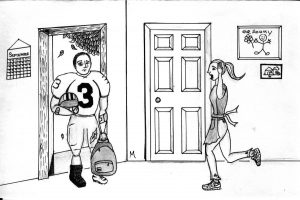The Northwestern University football team’s recent effort to unionize calls to attention one of the biggest problems in football today: the constant danger of suffering serious injury from playing.
The main motive behind the Wildcats’ decision was a pursuit of benefits that would come from being part of a union, with health insurance foremost among these perks. Football has always been known for the susceptibility of its participants to concussions and injuries in general, a stereotype that has come to light again recently.
In March, former 49ers linebacker Chris Borland made an early curtain call to his football career due to a fear of future injuries. Borland has been open about his rationale for retirement.
What stood out most to me about what Borland said was how fans view football safety. He believed that fans couldn’t appreciate the dangers of the sport from their couch. He said that if any fan were to play one game of football they wouldn’t love the game the way they do anymore.

I can admit that I am probably one of these fans. I have never played one down of organized football in my life, but still love the excitement that the game brings to my household every fall Sunday. And when concussions or other safety issues are brought up I hardly give it a second thought. But is it time to give it that second thought?
I’m not saying that football should be banned at any level, that would not be fair to the fans or to the people who choose to play the game. I just think that we need to realize how much is at stake when playing, especially for people who are playing at such a young age.
While organizations like Pop Warner have taken massive strides to make the game safer, they can not remove the natural danger from the game.
Despite using better padded helmets that are built to protect against a concussion, the hits, and general wear and tear of football put the players at constant risk of head injuries that can affect their lives in the future.
There are countless stories of former NFL players who had to deal with psychological difficulties in their lives because of concussions they suffered while playing. One example, Junior Seau, was inducted into the Hall of Fame this year despite controversy surrounding him and head injuries.
Seau committed suicide in 2012 because of chronic traumatic encephalopathy, a form of neurodegenerative brain damage, caused by the wear and tear of playing professional football for 16 years. Seau’s family was one of few that allowed research to be done on Seau’s brain following his death.
While this is an example of someone who played football for virtually his whole life and played an especially dangerous position, linebacker, severe brain injuries are still a legitimate possibility for kids or teenagers who play the sport. It only takes one bad play to cause a concussion. Once someone suffers one concussion, their likeliness to suffer a second increases. Once they have two, they are more likely for a third, and so on.
No football organization ignores the dangers of the sport and strides are being made to make the game safer at every level. However, players and those allowing them to play need to realize the prevalent danger that comes in just playing the game.






